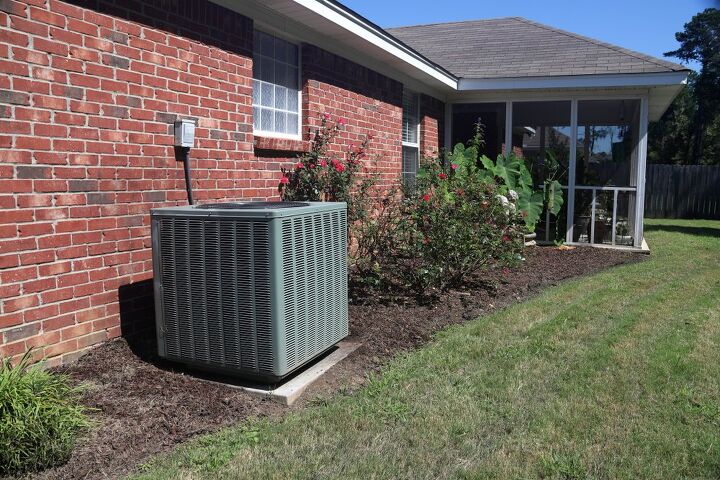7 Types Of Home Cooling Systems (With Photos)

Air conditioning, also referred to as cooling, is more intricate than heating. With heating, energy is used to create heat, whereas, air conditioning systems use energy to remove heat. While you may know how to turn on your air conditioning, do you know which type that you have? Although conventional air conditioning systems are what first comes to mind when you think of cooling, there are other alternatives that use less energy.
There are essentially seven main types of home cooling systems: central air conditioning, room or window air conditioners, ductless mini-slit systems, heat pumps, evaporative coolers, radiant cooling, and fans.
It’s important to know your type of home cooling system, so you can better assess problems when they arise. Understanding the specific cooling component also helps with HVAC maintenance. So, if you’ve ever wondered, “what type of cooling system does my home have?” or “which home cooling system is best?” You’ve come to the right place.
Do You Need a Heating and Cooling Contractor?
Get free, zero-commitment quotes from pro contractors near you.

Central Air Conditioning
The most common type of home cooling system out there, central air conditioners are designed to cool your entire house. These systems consist of a compressor unit that is located outside of the home and channels air to an indoor coil to be conditioned and dispersed through air ducts. Central air conditioners distribute cool air via a system of supply and return ducts.
The supply ducts and registers, which are commonly found within openings in ceilings, floors, and walls, are what carry the cooled air from the conditioner to the home. As the air circulates, it becomes warm and is “returned” to the central air conditioner via the return ducts and registers. The ducts are connected to vents and each room has one to provide cool air and another that returns it for recirculation.
There are two main forms of central air conditioning: split system units and packaged units.
Split System Units
With split-system central air conditioning, there is an outdoor metal cabinet that houses the condenser and the compressor and an indoor cabinet that encompasses the evaporator. In most split-system units, the indoor cabinet will also contain a furnace or the indoor component of a heat pump. The evaporator coil is fitted in either the main supply duct of this furnace (or heat pump) or in the indoor cabinet itself.
If your home is already outfitted with a furnace but does not have an air conditioner, a split-system central air conditioner is typically the most economical option.
Packaged Units
As the name suggests, packaged central air conditioners have the evaporator, condenser, and compressor packaged together in one cabinet. You’ll either find these cabinets on a concrete slab on the side of the house or on the roof. Although this option is common in residential settings, you’ll also often find them in small commercial buildings. Both the air supply and return ducts come from inside through the exterior wall of the home or roof, connecting with the packaged unit.
These units usually also include a natural gas furnace or electric heating coils. In fact, the combination of a central heater and air conditioner removes the need for a standalone furnace inside of the home.
Heat Pumps
Heat pumps work similarly to central air conditioners, with the added advantage of dual functionality. While they also operate with indoor refrigerant coils and outdoor compressors, the process can be altered to deliver heat instead of cooling. The advantage of heat pumps is that they streamline your heating and cooling into one system, which enhances the efficiency of your HVAC system. However, the drawback is a lighter performance.
Pro Tip: If you’re unsure whether you have central air or a heat pump, switch on your heating. If the outdoor unit starts working without making additional noise, you have a heat pump. You can also find the model number on your outdoor unit and do a quick internet search!
Room/ Window Air Conditioners
Although commonly referred to as window air conditioners, room air conditioners can be mounted either in your windows or through your walls. In either application, they operate the same and the compressor is located outdoors. Instead of cooling your entire house, these units are designed to cool singular rooms. For this reason, a number of room air conditioners may be required to achieve the desired cooling effect.
The main advantage to this cooling system is that the units cost far less than installing a central air conditioner. In fact, room air conditioners are the most affordable option on this list. They involve a single unit, which is installed directly in the room it will cool. While this system uses less energy than central AC or heat pumps, they don’t deliver as much cooling and are more prone to breakdowns.
When trying to determine the energy efficiency of a room air conditioner, look for the EER – which refers to the cooling output divided by power consumption. The higher the EER rating, the more efficient the unit.
Ductless Mini-Split Systems
Ductless mini-split air conditioners are not as popular in the United States as they are overseas, but may be the ideal choice for room additions or homes that lack ductwork. As the name suggests, ductless mini-split systems function without circulating air through air ducts. Like central air conditioners, these systems have indoor air handling units and an outside compressor/ condenser.
However, the distinction between the two is that, with ductless mini-split systems, each room or zone being cooled has its own air handler. The indoor units are connected to the outdoor unit through a conduit that carries power and refrigerant lines. These indoor units are usually installed on a wall or ceiling. The major advantage of ductless mini-split conditioners is their flexibility, as the existence of dedicated units makes it easier to meet the different needs of different rooms.
Evaporative Coolers
Also known as swamp coolers, evaporative coolers are not as common as vapor compression (refrigerant) air conditioning units. Though, they are often the most practical choice in dry climates, like the Southwest. Instead of having refrigerants, evaporative coolers pull fresh air from the outside through moist pads to be cooled via evaporation. This cool air, as well as humidity, is then distributed throughout your home.
Evaporative coolers may be attached to your ductwork like central air systems or come in a portable alternative. In the summer, they can save you as much as 75% on cooling costs since the only mechanical component that consumes electricity is the fan. Not to mention, as the technology is simpler, you can expect to spend about half the price of a central air conditioner for an evaporative cooler.
There are two main types of evaporative coolers: direct and indirect.
- Direct evaporative coolers add moisture to a home, which is generally an advantage for arid climates.
- Indirect evaporative coolers function somewhat differently, as the evaporation of the water occurs on one side of a heat exchanger. Indoor air is pulled across the other side of the heat exchanger where it is cooled but does not collect moisture.
Both types of swamp coolers start to lose effectiveness as humidity increases, since humid air has more difficulty carrying additional moisture.
Radiant Cooling
Radiant cooling is designed to cool a floor or ceiling by absorbing the heat that radiates throughout the rest of the room. When ceilings are cooled, this is typically done with radiant panels. Whereas, when the floor is cooled, this is generally referred to as radiant floor cooling. Although potentially appropriate for dry climates, radiant cooling is not ideal for homes in more humid climates as condensation collects on the panels when they reach a temperature below the dew point of the air in the space.
In North America, most radiant cooling applications have been done by suspending aluminum panels from the ceiling that circulate chilled water. Though, to be effective, the panels need to maintain a temperature as close as possible to the dew point in the home. The house also has to be kept dehumidified.
If you live anywhere other than an arid climate, you’ll have to have a supplementary air conditioning system to keep the humidity in your home low, which adds to the overall cost. Also, the limited use of radiant cooling in the U.S. has created concerns over the quality and number of professionals that can successfully install, maintain, and repair these systems for residential use.
Do You Need a Heating and Cooling Contractor?
Get free, zero-commitment quotes from pro contractors near you.

Fans for Cooling
Whether it’s floor fans, ceiling fans, table fans, window fans, or fans mounted to a pole or your walls, circulating fans can deliver a wind chill effect that enhances the comfortability of your home. Of all these types of fans, ceiling fans are considered the most effective for home cooling purposes. They efficiently circulate air in a room to create a draft that services the entire space, and can increase comfort all year round.
For best results, operate your ceilings fans counterclockwise in the summer and clockwise in the winter. During winter months, you should also lower the speed to help move warm air that collects on the ceiling to the lower living levels of the room.

Jessica considers herself a home improvement and design enthusiast. She grew up surrounded by constant home improvement projects and owes most of what she knows to helping her dad renovate her childhood home. Being a Los Angeles resident, Jessica spends a lot of her time looking for her next DIY project and sharing her love for home design.
More by Jessica Stone




















![How Much Weight Can a 4×4 Support Horizontally? [It Depends!]](https://cdn-fastly.upgradedhome.com/media/2023/07/31/9070333/how-much-weight-can-a-44-support-horizontally-it-depends.jpg?size=350x220)
![The 5 Best Angle Grinders – [2022 Reviews & Buyer's Guide]](https://cdn-fastly.upgradedhome.com/media/2023/07/31/9071326/the-5-best-angle-grinders-2022-reviews-buyer-s-guide.jpg?size=350x220)












